John Christian Rosenlund, FNF, speaks about the challenges of shooting "The Emigrants", by Erik Poppe
A historical saga in natural lightThe film is an adaptation of a novel that is very popular in Sweden. Was it a challenge for you ?
John Christian Rosenlund : The original novel (in nine parts) is indeed one of the pillars of Swedish literature. We study it in school, and I think almost everyone in Sweden has read it or at least heard of it… So, it was a real challenge for us, especially given that we’re from Norway ! And then, as with any major literary work, everyone has their own images in mind when they read the book. Of course, it is a complicated thing to approach such a work, to condense any story into a film without leaving too many things out, and especially to offer a more modern version of the one produced fifty years ago… By the way, we received the blessing of Jan Troell and Liv Ullman, who enthusiastically supported our undertaking this adventure. In the end, I think that asking a director from a neighboring country to take on the story profoundly participated in not making a remake just for the sake of making a remake. Here, a different vision is offered, one which remains within Kristina’s (Lisa Carlehed) point of view as much as possible and includes the exceptional dimension of a woman’s destiny.
You know, at that time, Scandinavia was going through very hard times. People really had nothing to eat, and almost half the population decided to flee to America. Entire families who had never seen the sea boarded boats intended for cattle and embarked on an extremely risky passage to the New World. Once they got there, like all migrants, they were confronted with a culture, a language that they did not know, and they got taken advantage of… The fate of the women who survived is very similar to that of today’s migrants. Confined within their role as mothers by custom and religion, they cannot learn the language, and remained withdrawn from society. It’s really all these similarities with what is happening today in our old Europe that made me understand why it was important to offer not a new, more epic version of the book, but an adaptation in which each scene must resonate with what we’re experiencing now.
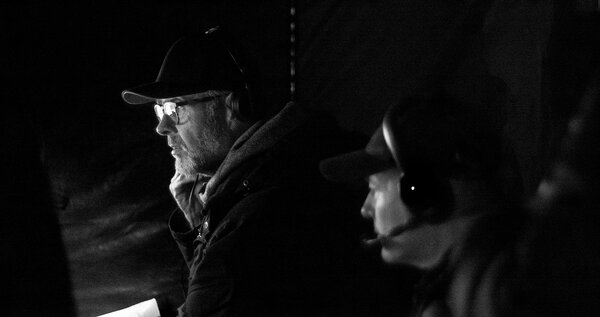
As a cinematographer, what is your relationship with period films ?
JCR : The danger is that when you launch into a period film, it can be too easy to be clever with costumes, sets and lighting… As you start with a blank slate and you control almost everything, the temptation to strive for beauty can be great.
That’s why the director and I racked our brains so we wouldn’t end up with a splendid new adaptation, but rather with a film where you are intimately related to the characters and the situations. That’s why we shot the entire things with a shoulder camera and we tried not to cut the takes when filming scenes. This wasn’t to keep a feeling of real time (because the takes were all edited later on) but rather to keep a rhythm and a dynamic going between the actors and the camera. This set-up, which was approved in preproduction, allowed me to completely reconsider the traditional way of lighting a film. As the camera was to be extremely free on set, with very wide angles covered, and movements between indoors and outdoors, for example, I immediately understood that we’d need to avoid any type of cinema lighting. Only natural lighting and prop lighting (candles, torches, oil lamps, etc.) would be used on this film, which presented us a challenge in having to list.
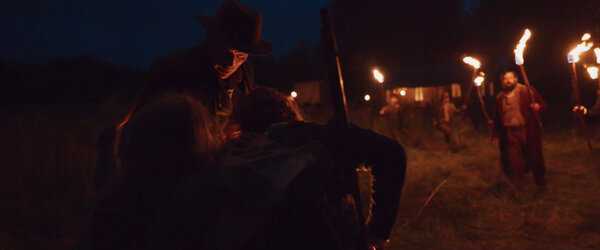
Where did you shoot ?
JCR : We shot the film mostly in Sweden, both the first part which was actually set there, and the second part, set in America, for which we were able to find almost all the appropriate locations. Only the scene in the pioneer village and the arrival in the port of New York were recreated in Romania, in a studio in Bucharest. For the record, the scene where the boat arrives in the United States was at the very end of the shooting script. It was of course the film’s most expensive sequence, with two hundreds live extras, and more than a thousand digital doubles that would be embedded in the backgrounds. All shot in a splendid set originally built for an American TV series and which they’d kept there. It was very important for us that this scene would literally plunge the viewer into the event, exactly like this Swedish family who had probably never seen more than twenty people at a time in their life and who find themselves amidst this ant colony of people ! This scene was a real production nightmare, especially because of Covid, which I caught the day before, as did the producer, forcing us to stay off set and allow the others to manage without us. A snowstorm was an additional obstacle and because of it, the crew had only a few hours to film the scene. My cameraman told me afterwards that the last shots were shot at nightfall, at 10,000ISO !
Fortunately, the film was finished, and a few days later everyone was repatriated because Covid was spreading rapidly !
How did you approach the choice of the main locations ?
JCR : As we had decided to shoot almost everything in natural light, there was a lot of preparation work with both the set crew and the assistant director in order to optimize each location according to the course of the sun. All the sets, such as the different houses the protagonists lived in, were reconstructed. The only hitch was that filming had to be postponed by two months, from late summer to mid-autumn, with much shorter days than originally planned for. That’s why on some sets I had to resort to some external sources to fake the sun. This is the case, for example, in the scene in the church, at the beginning of the film.
It’s really very much in the spirit of Les Moissons du ciel, isn’t it ? There’s even a shot of the train that could be taken directly from Malick’s film !
JCR : Yes, you might say that. In any case, this scene was a very conscious tribute to that film...
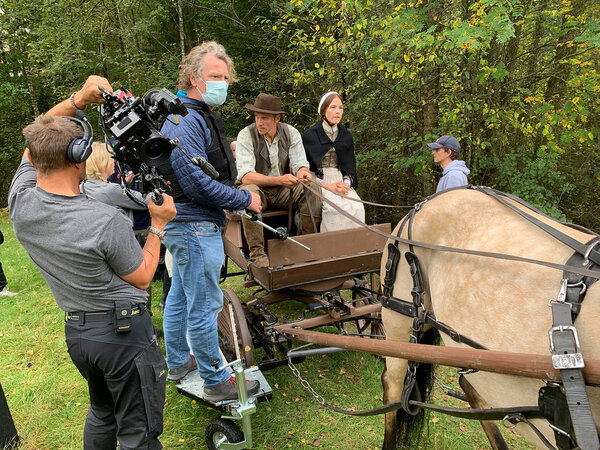
Are you holding the camera on this film yourself ?
JCR : No, although I have been known since my beginnings in documentaries for my shoulder camera work, I found that on this project, it was too complex to manage both the camera and the lighting. For that reason, I entrusted the camera to Martin Otterbeck, FNF, with whom I often work as a second camera and in whom I have complete trust. At the start, the producers were not necessarily reassured by our idea of working in this way and of using only natural light and prop lights... But as the preparation progressed, and seeing the many screentests we did, they ended up being convinced by the concept. I also want to insist on the importance of sharing images from the very first days of filming. For this, I use the DryLab system, which I helped develop. It is an in-the-cloud service for managing dailies that allows you to share the color graded and labeled dailies on an iPad with all the crew members. This makes it possible to bring up a particular take when you’re on set, make sure there’s visual continuity, and then constantly continue to discuss with the producers or the rest of the crew to anticipate the next steps and take the right artistic decisions.
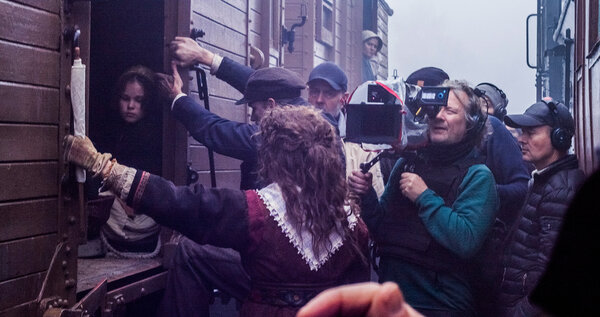
Let’s talk a little about the preparation, and how you managed for the night scenes.
JCR : As it’s a period film, the available light sources were candles, possibly outdoor torches, or kerosene lamps – but only once they arrive in United States. Indeed, throughout the first part in flashback which takes place in Sweden, the protagonists do not at all have the means to have kerosene lamps, and their little house is lit with simple candles. It was also interesting to visually regulate the night lighting setup, beginning with as much restraint as possible, such as a single candle lighting the entire room, and then beginning to multiply the sources (such as on the boat, where many people are together) and then in the interiors in the New World, where you feel more comfort, more depth in the image thanks to the growing number of sources.
For the candles, I didn’t really have any other options. But for the kerosene lamps, I started to do very concrete research. Especially because of the sequence of the boat in the storm, on which we intended to use about twenty sources of this type on set, it was impossible for safety reasons to use real lamps filled with flammable liquid !
The first idea was to use small halogen lamps that could be hidden in the props, and whose color temperature seemed to me closest to that of flame. But I quickly found myself confronted to a low ratio of power to time on battery. Indeed, this type of bulb cannot last more than about a dozen minutes on battery power. Beyond that, you have to thread a power cable through the actor’s costume and connect it to a low voltage transformer, or a sufficiently large battery pack. So, I asked my friend Henrik Moseid (Softlights) to develop a kind of LED bulb specially designed to imitate a flame, while maintaining a life when powered by a small battery that could be hidden inside a hurricane lamp. After several tests with LEDs rated between 1,800K and 2,200K, we realized that in these very low color temperatures, we lost a lot of nuances on the actors’ skin. Especially when compared with an incandescent source (candle or tungsten lamp on a dimmer). So, we had to develop a sharp mix between deep red, amber, lime and 2,200K white elements.
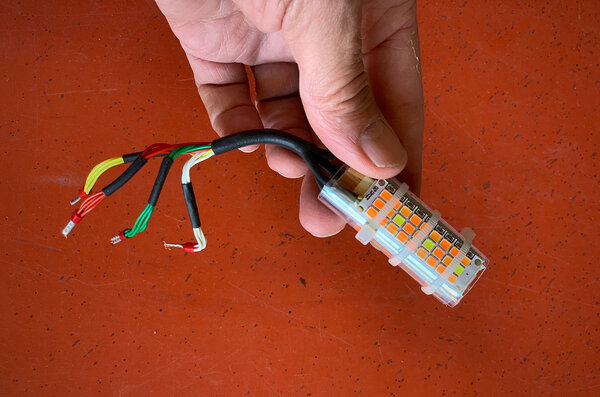

After a test on location, on a face lit on one side with a candle and on the other with the “Flame”, my colorist and I agreed that it was almost impossible to tell the difference between the two. So, I gave Henrik the go-ahead to produce enough equipment for the film, most of it being very small equipment designed to be included in the prop lighting, plus a few larger, more powerful versions that could be used off-screen (in the background in houses, or in a simple Ikea Chinese lantern perched off-screen).
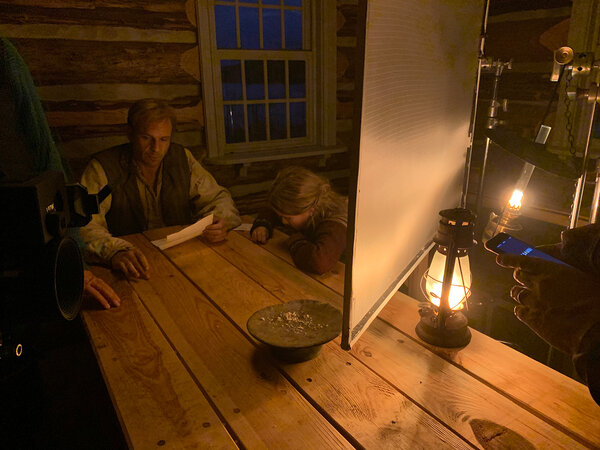
Can you make the “Flame’s” light flicker to imitate the movement of a flame ?
JCR : The Flame is indeed equipped with a wireless multi-directional lighting control solution, which not only allows you to adjust its intensity, but even the chromatic balance if necessary. It can also be used to make variations and wobbling. Even if in practice, on this film, we didn’t much resort to moving flames. In fact, in real life, candles and oil lamps don’t flicker that much. Unless there is wind, the flame is very stable so there is no need, as with a campfire effect, to vary the brightness.
One of the first night scenes in the United States is also one of the film’s key scenes, with the discussion between Katharina and Ulrika in the train car taking them to Minnesota...
JCR : This scene is a good example. First of all, it’s a long take that wasn’t cut during editing. Everything there was lit with the Flames. While we were rehearsing in the train car with the two actresses, I noticed on the feedback that there was a little dynamic effect missing at the heart of the discussion between the two women. I asked the props master if we could have a character pass by in the background on the platform, with a hurricane lamp in his hands. Because all the lamps that we had prepared had already been used on this shot, it only took him a few minutes to outfit a naked lamp with one of the Flame modules we had in stock, so that we could have the extra pass through the scene. This is the advantage of this system, because it is very compact, has good battery life, and can be controlled wirelessly via Bluetooth.
What sensitivity did you shoot at ?
JCR : Most of the film was shot in Alexa LF at ISO 1,200 with just three fairly wide lenses from Zeiss’ Signature Prime series. (14/18/24mm). But for some night sequences, I also used my personal Panasonic S1H, pushing it up to ISO 10,000, and saving the images on an external Raw Atomos Ninja 5 recorder in 4K. For example, the sequence where Katharina comes back to the community at night after her encounter with the Indians, was shot in this configuration. Torches were the only sources. There’s just a paper lantern perched with a big Flame module to control the contrast on the faces a bit. That’s all...
(Interview conducted by François Reumont and translated by A. Baron Raiffe, for the AFC)
 En
En Fr
Fr





